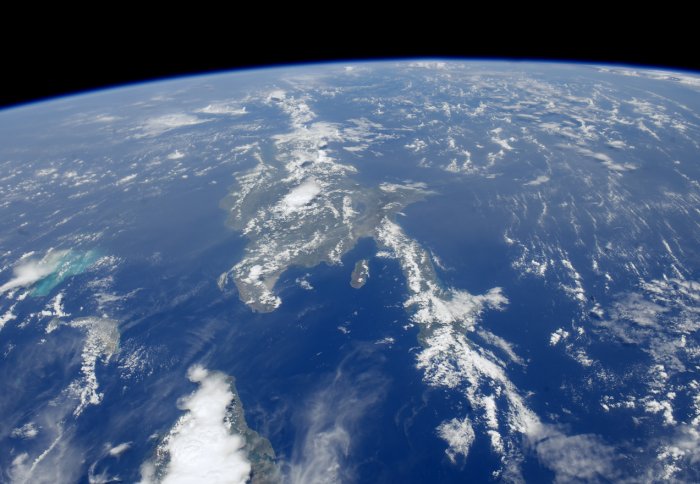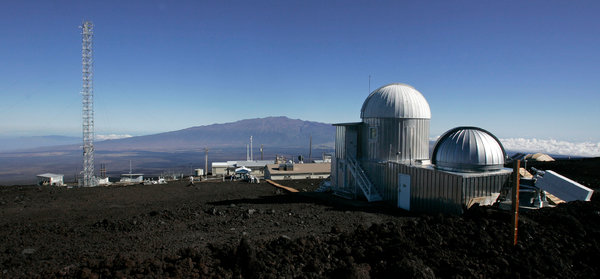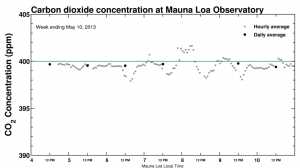It’s official. The observatory atop Mauna Loa in Hawaii recorded on Thursday this week that we had reached 400.08 parts per million of CO2 in the atmosphere. It was barely a week ago that I wrote about following the Keeling Curve on Twitter. And if you subscribed this week then you would have seen the milestone reached in real time.
In a New York Times article written by Justin Gillis on May 10, he quotes Dr. Maureen E. Raymo, a geologist at Columbia University. “It feels like the inevitable march toward disaster,” she states. Dr. Raymo points out that the last time the 400 mark was surpassed, based on the geologic record, was the end of the Pliocene, a period before the beginning of the Ice Age. In the Pliocene Africa’s Savannah was fully covered in forests. Ellesmere Island in the Canadian Arctic supported beavers, larch trees, horses and giant camels. Our planet was as much as 4 Celsius (7.2 Fahrenheit) degrees warmer than where we were in the mid-19th century at the dawn of the Industrial Age. And sea levels were higher, estimated to have elevated been 10 and 20 meters (33 to 66 feet). Dr. Raymo points out that even at the low end one quarter of the U.S. population would be impacted by such sea level changes.
Other reactions around the world have been variations on the same theme. Sir Brian Hoskins who heads up the Climate Change Committee at the Royal Society in the UK states: “Before we started influencing the amount of carbon dioxide in the atmosphere, over the last million years it went between about 180 and 280 parts per million…. Now, since the Industrial Revolution and more in the last 50 years, we’ve taken that level up by more than 40% to a level of 400 and that hasn’t been seen on this planet for probably four million years” Hoskins in his comments puts a positive spin to things stating, “around the world, there are things happening, it’s not all doom and gloom.” He is referring to what China is doing in its latest five year plan which sets a goal of reversing the environmental damage done by unprecedented growth over the last thirty years. For China this involves a heavy push to renewable energy and away from coal and fossil fuels.
Dr. Raymo as a geologist takes her perspective from the geological record of past ice ages separated by interglacial warming periods. She points out that it doesn’t take a lot of increased CO2 to get warming going. For example in the last interglacial period it took a few thousand years for the ice sheets on Greenland and West Antarctica to melt. The interglacial period lasted 30,000 years, three times longer than the one we are experiencing today. And at no time did CO2 levels approach 400 parts per million in those 30,000 years. She further states that even if we stopped the rise in CO2 levels today, that the atmosphere would continue to warm for centuries. “For me personally that’s the scary thing….we really don’t know what we’ve already committed ourselves to,” she concludes.
There may be some consolation for the climate change deniers. The 400.08 reading at Mauna Loa is the Earth breathing out in the annual cycle that is clearly visible on the Keeling Curve graphs (the plot below is of observations for the last week). That reading should drop below 400 later in the year according to James Butler of NOAA who is quoted in an interview with the BBC as stating: “Carbon dioxide has some variability on an hourly, daily and weekly basis, so we are not comfortable calling a single number — the lowest we will go is on a daily average, which has happened in this case…this is the first time the daily average has passed 400 parts per million at Mauna Loa. Probably next year, or the year after that, the average yearly reading will pass 400. In eight or nine years we will probably have seen the last CO2 reading under 400 parts per million.”
But climate change deniers, don’t feel too complacent. I leave you with the last word from Dr. Hoskins whose previous optimism in reference to China is countered by another recent statement,Given current human activity, levels of CO2 could be near 800 parts per million by the end of the Century.











